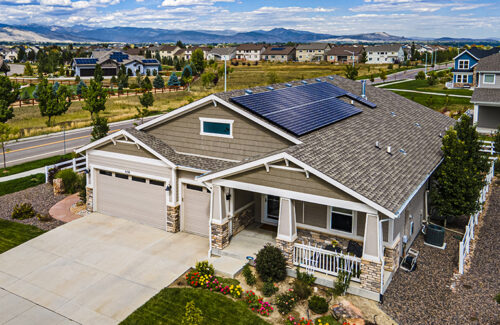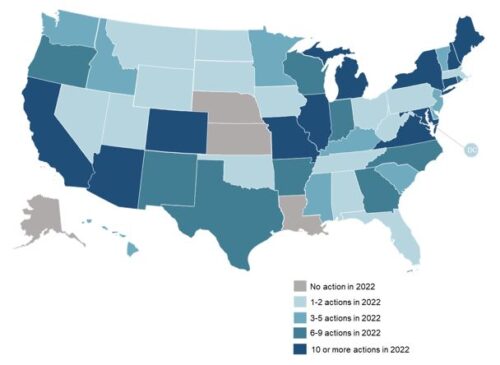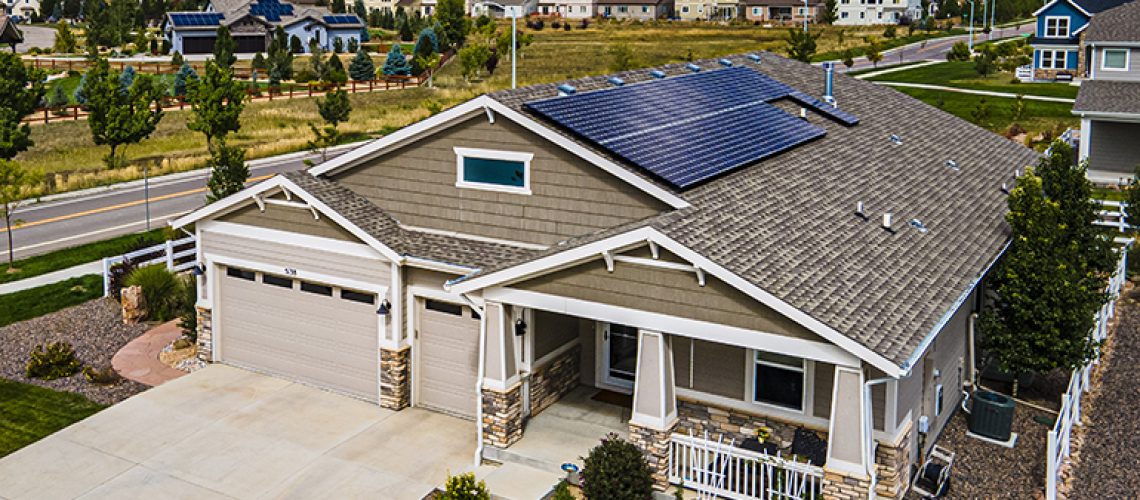
Namaste Solar
The N.C. Clean Energy Technology Center (NCCETC) released its 2022 annual review and Q4 update edition of The 50 States of Solar. The quarterly series provides insights on state regulatory and legislative discussions and actions on distributed solar policy, with a focus on net metering, distributed solar valuation, community solar, residential fixed charges, residential demand and solar charges, third-party ownership and utility-led rooftop solar programs.
The report finds that 46 states and the District of Columbia took some type of distributed solar policy action during 2022, with the greatest number of actions relating to net metering policies, community solar policies and residential fixed charge increases. The states taking the greatest number of actions are Illinois, California, New York, Connecticut, Maine, Colorado and Michigan.
2022 solar policy actions
The report highlights ten of the top distributed solar policy trends of 2022:
- States moving away from traditional net metering;
- Net billing becoming the dominant successor tariff structure;
- States incorporating LMI-specific provisions in solar programs;
- Focusing on grid access fees and minimum bills;
- New states considering community solar programs;
- Growing use of time-varying compensation rates for distributed generation;
- Encouraging distributed generation systems paired with battery storage;
- States tying labor requirements to solar programs;
- Distributed generation programs increasing in complexity; and
- States taking an iterative approach to distributed generation program design.
“2022 was a significant year for low-to-moderate-income (LMI) solar access, following a similar trend from 2021,” observed Justin Lindemann, policy analyst at NCCETC. “A plethora of states have committed to incentivizing LMI participation through carve-outs, rebates, as well as billing and tax exemptions. Much of the progress was related to improving community solar engagement. For example, new programs were enacted in New Hampshire and California that prioritize LMI community solar expansion.”
 A total of 285 state and utility level distributed solar policy and rate changes were proposed, pending or decided in 2022. The report notes that ten of the most active states in 2022 for solar policy developments were:
A total of 285 state and utility level distributed solar policy and rate changes were proposed, pending or decided in 2022. The report notes that ten of the most active states in 2022 for solar policy developments were:
- California, where regulators approved a net metering successor tariff and state lawmakers enacted legislation to create a new community solar program;
- Mississippi, where the Public Service Commission approved revisions to the state’s DG program rules and considered community solar program rules;
- Hawaii, where the Public Utilities Commission approved new DER program designs and an advanced rate design framework;
- North Carolina, where regulators considered Duke Energy’s proposed net metering successor tariff and allowed a third-party solar PPA at a military facility to proceed;
- Michigan, where Consumers Energy and DTE Electric requested approval to modify their DG program credit rates and implement additional fees;
- Maine, where legislators adopted changes to the net energy billing tariff rate program and a DG stakeholder group presented a DG successor program framework;
- Georgia, where the Public Service Commission increased export credit rates for Georgia Power’s net billing program, while declining to expand the limited retail rate net metering program;
- New Mexico, where regulators approved community solar program rules and Xcel Energy filed its proposal for a standby rate;
- Indiana, where regulators approved net metering successor tariffs for the state’s investor-owned utilities and the Indiana Supreme Court considered an appeal; and
- Florida, where the governor vetoed a bill that would have established a net-metering successor tariff and authorized the implementation of additional fees for customer-generators.
“This year, utility regulators considered several novel approaches to utility cost recovery for service to DG customers,” said Vincent Potter, policy analyst at NCCETC, “Michigan regulators denied an annual-average demand charge for DG customers; California regulators rejected capacity charges in favor of instructing utilities to use specific existing tariffs; and in Hawaii, regulators ordered the implementation of a framework for advanced rate design which will eventually replace demand charges and minimum bills in the state.”
In Q4 2022, 40 states and D.C. took some type of action on distributed solar policy or rate design. A total of 156 actions were tracked in Q4.
News item from the NC Clean Energy Technology Center



